#best smartphones buying guide
Explore tagged Tumblr posts
Text
Best Samsung Galaxy S23 series cases with screen protectors in 2023
#phonecase#accessories#samsung#review#best#amazon#screen protector#buying guides#shopping#mobile#gadgets#smartphone#recommends#fntcase
3 notes
·
View notes
Text

Unleash the Power of Samsung M31s: Ultimate Review!
Welcome to our in-depth review of the Samsung M31s! In this video, we delve into every aspect of this incredible smartphone, exploring its features, performance, and capabilities. Whether you're a tech enthusiast or a casual user, this review is your ultimate guide to understanding the Samsung M31s. Join us as we uncover its strengths, weaknesses, and everything in between. Get ready to unleash the power of Samsung M31s!
Know more
#samsung m31s review#samsung m31s features#samsung m31s performance#samsung m31s camera#samsung m31s specifications#samsung m31s comparison#samsung m31s vs iphone#samsung m31s vs competitors#samsung galaxy m31s#best budget smartphones#smartphone buying guide#tech reviews#mobile gaming#samsung tips and tricks#smartphone photography#samsung accessories#samsung apps#mobile device management#android smartphones#samsung innovations#mobile technology trends#samsung product showcase#smartphone customization#samsung ecosystem#mobile productivity#samsung software updates#samsung user experience#smartphone durability#samsung warranty#smartphone storage solutions
1 note
·
View note
Text
🍉🇵🇸 eSims for Gaza masterpost 🇵🇸🍉
Which eSims are currently being called for?
Connecting Humanity is calling for:
Nomad (“regional Middle East” plan): code NOMADCNG
Simly (“Palestine” plan)
Gaza Online is calling for:
Holafly (“Israel” and “Egypt” plans): code HOLACNG
Nomad (“regional Middle East” plan): code NOMADCNG (can now be used multiple times from the same email)
Airalo (“Middle East and North Africa” plan)
Sparks (“Israel” plan)
Numero (“Egypt” plan)
For Connecting Humanity: if you sent an eSim more than two weeks ago and it is still valid and not yet activated, reply to the email in which you originally sent the eSim. To determine whether the eSim is still valid, scan the QR code with a smartphone; tap the yellow button that reads “Cellular plan”; when a screen comes up reading “Activate eSIM,” click the button that says “Continue.” If a message comes up reading “eSIM Cannot Be Added: This code is no longer valid. Contact your carrier for more information,” the eSim is activated, expired, or had an error in installation, and should not be sent. It is very important not to re-send invalid eSims, since people may walk several kilometers to access wifi to connect their eSims only to find out that they cannot be activated.
If a screen appears reading “Activate eSIM: An eSIM is ready to be activated” with a button asking you to “Continue,” do not click “Continue” to activate the eSim on your phone; exit out of the screen and reply to the email containing that QR code.
Be sure you're looking at the original post, as this will be continually updated. Any new instructions about replying to emails for specific types of unactivated plans will also appear here.
Check the notes of blackpearlblasts's eSim post, as well as fairuzfan's 'esim' tag, for referral and discount codes.
How do I purchase an eSim?
If you cannot download an app or manage an eSim yourself, send funds to Crips for eSims for Gaza (Visa; Mastercard; Paypal; AmEx; Canadian e-transfer), or to me (venmo @gothhabiba; paypal.me/Najia; cash app $NajiaK, with note “esims” or similar; check the notes of this post for updates on what I've purchased.)
You can purchase an eSim yourself using a mobile phone app, or on a desktop computer (with the exception of Simly, which does not have a desktop site). See this screenreader-accessible guide to purchasing an eSim through each of the five services that the Connecting Humanity team is calling for (Simly, Nomad, Mogo, Holafly, and Airalo).
Send a screenshot of the plan's QR code to [email protected]. Be sure to include the app used, the word "esim," the type of plan (when an app has more than one, aka "regional Middle East" versus "Palestine"), and the amount of data or time on the plan, in the subject line or body of your email.
Message me if you have any questions or if you need help purchasing an eSim through one of these apps.
If you’re going to be purchasing many eSims at once, see Jane Shi’s list of tips.
Which app should I use?
Try to buy an eSim from one of the apps that the team is currently calling for (see above).
If the team is calling for multiple apps:
Nomad is best in terms of data price, app navigability, and ability to top up when they are near expiry; but eSims must be stayed on top of, as you cannot top them up once the data has completely run out. Go into the app settings and make sure your "data usage" notifcations are turned on.
Simly Middle East plans cannot be topped up; Simly Palestine ones can. Unlike with Nomad, data can be topped up once it has completely run out.
Holafly has the most expensive data, and top-ups don't seem to work.
Mogo has the worst user interface in my opinion. It is difficult or impossible to see plan activation and usage.
How much data should I purchase?
Mirna el-Helbawi has been told that large families may all rely on the same plan for data (by setting up a hotspot). Some recipients of eSim plans may also be using them to upload video.
For those reasons I would recommend getting the largest plan you can afford for plans which cannot be topped up: namely, Simly "Middle East" plans, and Holafly plans (they say you can top them up, but I haven't heard of anyone who has gotten it to work yet).
For all other plans, get a relatively small amount of data (1-3 GB, a 3-day plan, etc.), and top up the plan with more data once it is activated. Go into the app’s settings and make sure low-data notifications are on, because a 1-GB eSIM can expire very quickly.
Is there anything else I need to do?
Check back regularly to see if the plan has been activated. Once it's been activated, check once a day to see if data is still being used, and how close the eSim is to running out of data or to expiring; make sure your notifications are on.
If the eSim hasn't been activated after three weeks or so, reply to the original email that you sent to Gaza eSims containing the QR code for that plan.
If you purchased the eSim through an app which has a policy of starting the countdown to auto-expiry a certain amount of time after the purchase of the eSim, rather than only upon activation (Nomad does this), then also reply to your original e-mail once you're within a few days of this date. If you're within 12 hours of that date, contact customer service and ask for a credit (not a refund) and use it to purchase and send another eSim.
How can I tell if my plan has been activated? How do I top up a plan?
The Connecting Humanity team recommends keeping your eSims topped up once they have been activated.
See this guide on how to tell if your plan has been activated, how to top up plans, and (for Nomad) how to tell when the auto-expiry will start. Keep topping up the eSim for as long as the data usage keeps ticking up. This keeps a person or family connected for longer, without the Connecting Humanity team having to go through another process of installing a new eSim.
If the data usage hasn't changed in a week or so, allow the plan to expire and purchase another one.
What if I can't afford a larger plan, or don't have time or money to keep topping up an eSim?
I have set up a pool of funds out of which to buy and top up eSims, which you can contribute to by sending funds to my venmo (@gothhabiba), PayPal (paypal.me/Najia), or cash app ($NajiaK) (with note “esims” or similar). Check the notes of this post for updates on what I've purchased, which plans are active, and how much data they've used.
Crips for eSims for Gaza also has a donation pool to purchase eSims and top them up.
Gaza Online (run by alumni of Gaza Sky Geeks) accepts monetary donations to purchase eSims as needed.
What if my eSim has not been activated, even after I replied to my email?
Make sure that the QR code you sent was a clear screenshot, and not a photo of a screen; and that you didn’t install the eSim on your own phone by scanning the QR code or clicking “install automatically."
Possible reasons for an eSim not having been activated include: it was given to a journalist as a back-up in case the plan they had activated expired or ran out of data; there was an error during installation or activation and the eSim could no longer be used; the eSim was installed, but not activated, and then Israeli bombings destroyed the phone, or forced someone to leave it behind.
An eSim that was sent but couldn’t be used is still part of an important effort and learning curve. Errors in installation, for example, are happening less often than they were in the beginning of the project.
Why should I purchase an eSim? Is there any proof that they work?
Israel is imposing near-constant communications blackouts on Gaza. The majority of the news that you are seeing come from Gaza is coming from people who are connected via eSim.
eSims also connect people to news. People are able to videochat with their family for the first time in months, to learn that their family members are still alive, to see their newborn children for the first time, and more, thanks to eSims.
Some of this sharing of news saves lives, as people have been able to flee or avoid areas under bombardment, or learn that they are on evacuation lists.
Why are different plans called for at different times?
Different eSims work in different areas of the Gaza Strip (and Egypt, where many refugees currently are). The team tries to keep a stockpile of each type of sim on hand.
Is there anything else I can do to help?
There is an urgent need for more eSims. Print out these posters and place them on bulletin boards, in local businesses, on telephone poles, or wherever people are likely to see them. Print out these foldable brochures to inform people about the initiative and distribute them at protests, cafes and restaurants, &c. Also feel free to make your own brochures using the wording from this post.
The Connecting Humanity team is very busy connecting people to eSims and don't often have time to answer questions. Check a few of Mirna El Helbawi's most recent tweets and see if anyone has commented with any questions that you can answer with the information in this post.
14K notes
·
View notes
Text
June of Doom Day 1 - "Help me."
| Failed Escape | On the Run | Fetal Position |
Catching up on June of Doom as much as I can haha. Next one I think I'll do is CCE, but for now, here's some Rowan/Sawyer content.
Sorry it's shorter than most of my works, haven't been feeling too motivated but I've been forcing myself to get there haha.
CW: Implied drugging, failed escape, intimate/yandere whumper, implied trauma, noncon touching (not sexual), concussions, slight gore
...
It had been three months since Sawyer managed to escape from Rowan. Those three months felt like a weight had been lifted off his chest, yet was still somehow more stressful than being in his kidnapper's grasp. He was glad to have freedom again, but terrified every time he went outside. Hell, even when he was inside his shitty motel room he was scared that Rowan would be somehow in his walls.
The fear made it so difficult to do things as simple as getting groceries and going to the laundromat.
There were so many people outside, everywhere. Rowan could blend in with them no problem, and then get Sawyer alone and take him back to his own personal hell.
But... there had been no signs of Rowan ever since Sawyer got out. There hadn't been any flowers on his doorstep, no messages on his phone, no emails to his old Indigo work account.
That was probably because Rowan had no idea where he was (hopefully) and Sawyer was now confined to using a cheap flip phone instead of his smartphone that Rowan had broke.
Sawyer tried not to think about Rowan. He tried to focus on the here and now, and the here and now was buying a few bags of chips at the gas station.
He did his best not to look over his shoulder the entire time he shopped. Every little sound made him jump. People chatting quietly with each other. The cashier running change for another customer. Someone opening the glass freezer door across the room.
Fuck, everything freaked him out nowadays. But he needed to get groceries sooner rather than later. His room had only a microwave and a mini fridge in it, so if he didn't want to go hungry tonight he needed food. He wanted nothing more than to buy a pack of cigarettes, but he couldn't even do that with his little money and lack of ID.
He set down the items he bought onto the counter and waited for the cashier to ring him up. Each moment felt like an hour.
"That'll be $8.36."
"Thanks," Sawyer said, fishing through his pockets. He took out some crumbled bills and counted them out, then dropped the money into the man's open palm. "Keep the change." He needed the money, but he also needed to get out of here asap.
The cashier thanked him. As soon as Sawyer got his change back he left. He went outside with his bagged goods, thankful for the cool breeze outside.
It was already dark outside and he only had the light of the streetlamps to guide him back to his motel room.
It was cold tonight, almost freezing. He should've gotten a jacket from the store, but he'd be fine without one. If he froze to death that would be preferable to going back to Rowan.
Breathing in the crisp air helped him feel a little better, less like he was suffocating under the stress of being outside. At this rate, he was going outside even less than when he was in captivity.
He thought a car was about to pass him, but when it started to slow down by the curb Sawyer's heart nearly stopped.
The car... looked exactly like Rowan's.
Rowan had found him.
No no no no no no no no no no no...
His blood turned to ice and his stomach twisted into knots. All he could manage to do was take a few steps back, dropping his bags of food. The car door opened, and out stepped Rowan. His hair was messier than usual and he wore all black clothing, which was a stark contrast to the cozy wool sweaters and dress shirts that Sawyer was used to seeing him in.
Sawyer didn't waste a second on standing around in shock. He immediately bolted off running in the alleyway right behind him. His lungs were already burning but he couldn't let that stop him. He could hear Rowan call his name from far behind, echoing off the walls.
"Help me!" Sawyer shrieked, running faster than he ever had before. "Someone help me, please! Help-!"
His words were cut short when he ran face first into a brick wall. He blamed the poor lighting for his misstep, and the throbbing pain in his head kept him from getting up as fast as he wanted to.
Rowan slowed down. He was cornered, so he curled up into a ball in an attempt to make himself seem smaller. Maybe it would work. Maybe if he tried hard enough he would just disappear.
"Sawyer," Rowan breathed out, clearly exhausted. Sawyer wasn't sure what happened between the kidnapping and now, but it looked like he had gone through some shit too.
But whatever happened to him wasn't Sawyer's concern. This was his kidnapper, his tormentor, the man who abused him for months. He wasn't going to pity him.
Rowan collapsed on his knees, then pulled Sawyer close to him. It felt strange being so close to someone again; it made Sawyer feel dirty.
Even with the awkward position, Rowan was so much stronger than Sawyer. There was no way he was breaking free of his grip any time soon.
"I missed you so much..." Rowan muttered against Sawyer's hair, squeezing him tighter. "So so so much." His hot breath made Sawyer turn his face away. He was desperate to escape this, any of it. Rowan flashed a knife in his direction, and that was all it took for Sawyer to stop squirming.
The last thing he needed was another injury from his deranged stalker.
Rowan tutted, examining the side of his head with his free hand. "Oh, poor thing. I bet that hurt. But don't worry," he cooed, kissing his forehead. "I'm going to take care of you. That's why you did all of this right? You just wanted me to pay more attention to you." A dark chuckle escaped his throat. "Well, you'll get it, don't you worry."
Next thing Sawyer knew, Rowan had tucked the knife away somewhere in his coat, then forced him to his feet.
Sawyer was sure he was concussed and most likely had a broken nose, so his balance was compromised. But as always, Rowan managed to keep him upright.
He steered them out of the alley and to his car. He contemplated putting him in the trunk, but settled for the backseat instead, since it looked like his beloved wouldn't be awake for much longer.
"You can relax, my dear." Rowan kissed his bloody nose. Sawyer didn't even have the awareness to be disgusted. "Since the typical punishments aren't working on you, I think I've worked up a new solution. You're not allergic to ketamine, are you?"
#rowan oc#sawyer oc#june of doom 2024#day 1#whump#yandere whumper#intimate whumper#implied drugging#tw noncon drugging#whumper x whumpee#whumpee x whumper#carewhumper
55 notes
·
View notes
Note
Recently I took a panorama of the Pittsburgh skyline at night that got a positive response. That was done on the spur of the moment with an iPhone. I want to do that again and more, but this time with a dedicated camera setup. It's been years since I've had one, so I'm basically starting over again. I'm mostly interested in getting day and night cityscapes, and maybe the carryings-on at this year's Anthrocon. Would you have any particular knowledge to pass on as I set off on this journey?
Since you didn't specify a budget I'm going to assume it is in the $10K range.
And you're probably thinking I'm going to suggest a Leica. Every dentist and his brother (who is also a dentist) gets a Leica. But I just can't take a camera brand seriously when they charge you an extra $2200 for the privilege of not being able to shoot in color.
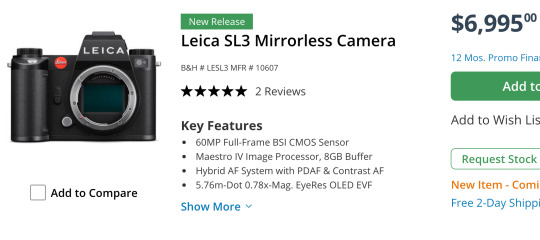
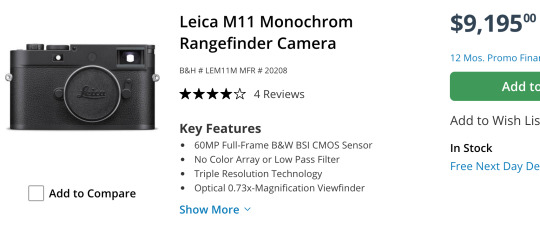
Sure, you can hit a single button in Lightroom to get B&W and save some money, but then you won't be able to brag about how limiting yourself to only shades of gray has opened up new artistic pathways in your brain while a clueless person responds in mumbles during their root canal.
What you really want for your landscapes is a Hassie.
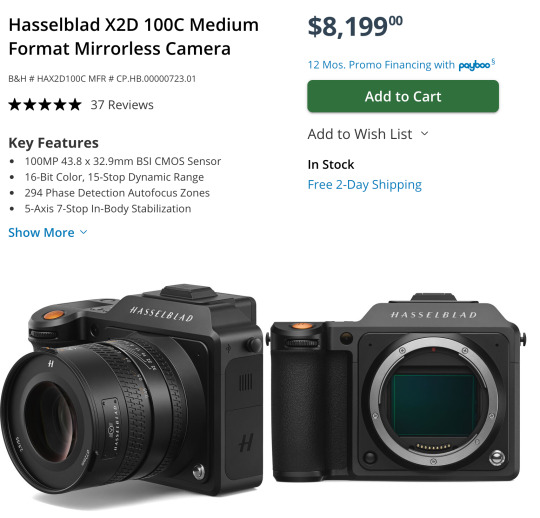
They were the first camera on the moon! How could you *not* want a Hasselblad? That is some camera gorgeousness right there. And it's so reasonably priced*!
*compared to their previous $40,000 camera systems.
And if you are doing landscapes with the Hassie you'll need a nice wide angle lens to go with it. This one is actually quite affordable*!
*compared to their previous $8000 lenses.

Can we all agree that is a work of art? They even use their H logo as the knurling.
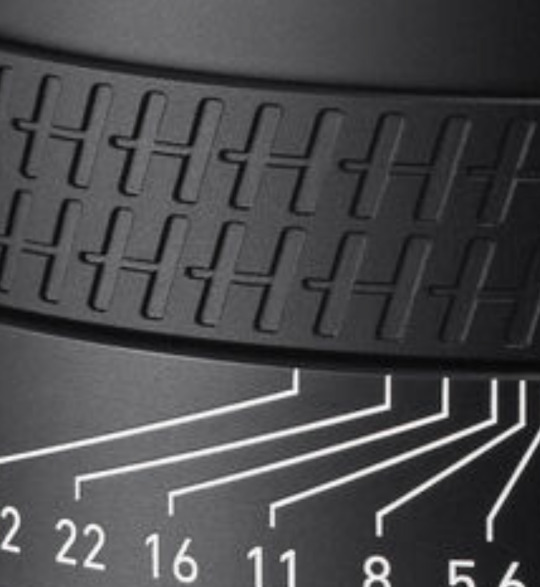
That is just so... extra. And I love it.
Out of the entire alphabet I've heard Hs give you the best grip.
Man, I almost wish I was a dentist just so I could buy a fancy camera.
Sorry... I was just having a little fun.
I never get to recommend the super cool expensive cameras. Because, ya know, the economy and the fact that only dentists have Hasselblad money.
You probably think I'm being silly but there actually is an entire community of dentist photographers keeping the high end camera market alive.
Okay, let's get started...
Landscape Buying Guide
Opening Thoughts
For landscapes I would highly suggest a full frame camera and a high quality wide angle lens.
Full frame has several advantages but it is not necessary. You can go with a smaller sensor like APS-C and get great images. Personally I would not go any smaller, but there have been some great landscapes taken on micro 4/3 and even smartphones. Technique, knowledge, experience, and composition will usually win the day over a camera, but having a nice camera makes things a lot easier.
At this point, with full frame options being very affordable now, the main reason to get a smaller sensor is if you want a smaller system that is easier to carry for extended periods and easier to pack when traveling. Or if you aren't sure you want to take on photography as a hobby, you can get an old APS-C DSLR for under $200 to learn with and test out.
So if you need a very cheap OR very compact system, APS-C and Micro 4/3 might be worth considering, but a bigger sensor will cause less frustration most of the time.
Froggie Note: The expensive Micro 4/3 and APS-C systems are the compact ones. The cheap systems are about as bulky as full frame.
The biggest advantages to full frame are low light shooting, lens selection, and field of view. Full frame cameras have many, many more lenses to choose from. And since the sensor is bigger, it is much easier to get a wider field of view that is often needed for landscapes. And the high ISO noise performance tends to be better on full frame.
However, you can use full frame lenses on APS-C camera bodies within the same ecosystem. They just get a little... zoomier. Roughly 1.5x zoomier. A 35mm acts like a 50mm, for example. So if you want to spend a little less now you can get an APS-C camera with a full frame lens and then upgrade to full frame later on without having to buy a new lens. Full frame lenses work on APS-C bodies but not the other way around.
Most landscapists have a really solid 16-35mm lens and that covers almost all of their needs. So I would suggest something comparable. Please don't get suckered into some crazy 18-300mm superzoom. Just get the focal range you need for the photos you want to achieve.
A purpose-built lens always outperforms one that was made to do everything.
As far as where to get used gear, I highly recommend using KEH or MPB when buying used camera bodies. They check every device and offer between 3 and 6 months warranty to make sure the device won't crap out on you. Lenses are typically a lot more robust and a safer thing to buy on eBay or Facebook Marketplace if you can find a better deal. But the security of having a warranty and a return apparatus if something goes wrong might be worth the extra price when using these two sites.
I am going to recommend Canon, Nikon, and Sony systems. I feel they have the most complete ecosystems with gear that spans all budget ranges. I'm not saying there aren't good cameras from other brands, but you have to remember every camera has an ecosystem surrounding it. There are accessories and upgrade paths and niche lenses that may not be available with other brands. I think Fuji has some tempting options and if you like the look of vintage film photography, their emulation options are quite stunning. Their cameras are also quite attractive and have very satisfying knobs. But I still can't recommend them unless you have a specific reason for wanting their gear.
Just remember that for every Canon DSLR I recommend there is a comparable Nikon option available as well. There are more lenses for a Canon full frame DSLR body than any other brand with Nikon coming in a close second.
So if you choose not to go mirrorless yet, the Canon and Nikon DSLR camera ecosystems are immense and have tons of gear and accessories available to go with them. And since used gear holds up really well, those ecosystems will survive for decades.
Should you buy a mirrorless camera or a DSLR?
Mirrorless cameras are the latest camera technology for interchangeable lens camera systems. At this point they are superior in every aspect and they continue to improve year by year. Because of that, used DSLRs have plummeted in price. This allows people greater access to a starter ILC (interchangeable lens camera) without a significant investment. You can get professional quality images on either format, but mirrorless has a shallower learning curve and much better automatic modes.
The in-body image stabilization (IBIS) stabilizes *every* lens and the eye tracking autofocus make "focus and re-compose" extinct. These are huge selling points for a lot of people. With IBIS you can take photos with up to 2-4 second shutter speeds without a tripod. And never missing focus on a human or animal or bird is pretty cool too.
DSLR camera bodies are no longer being designed by most of the major manufacturers. Thankfully Canon and Nikon developed plenty of bodies and lenses, so you will always have options and upgrade paths. But you will not be able to upgrade to systems with the latest advanced features.
The best DSLRs available are probably the Nikon D850 and the Canon 5D Mark IV. That is as good as it will ever get. The technology ends there. So if you want to enter an active camera ecosystem then you will have to get a mirrorless camera.
DSLR Camera Systems
Full Frame DSLR Camera Bodies
Canon
If you buy a used DSLR, there are some very affordable full frame options. In fact, the classic much-praised budget full frame Canon 6D can be had for under $300 right now.

This is an old camera. It has no fancy features. It only has 20 megapixels. It just does what it says on the tin. But it has a big sensor and a *ton* of really cool lenses available for it.
If you are specifically looking to create really high resolution panos, you could also look at the 50 megapixel 5DS R for around $1000.
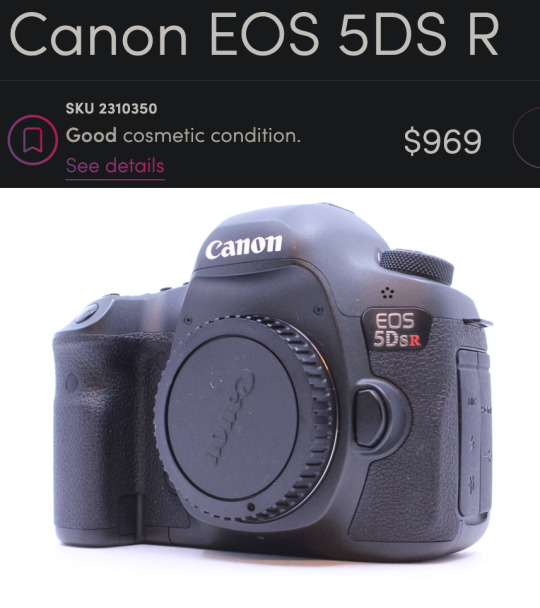
There is a community of landscape pano-maniacs that love to create "gigapans" that have endless amounts of detail where you can zoom in and find new details in every photo. I was only able to create a 120 megapixel photo, but you can still find things like people starting a campfire and a dude fishing and a truck on a far off bridge. So even though this seems expensive for a DSLR, you are looking at another thousand bucks to find anything with more megapixels than this bad boy, so it is quite a good deal relatively speaking.
Nikon
Probably the best DSLRs ever made were the Nikon D800 series and you can get the Nikon D800 for $464.
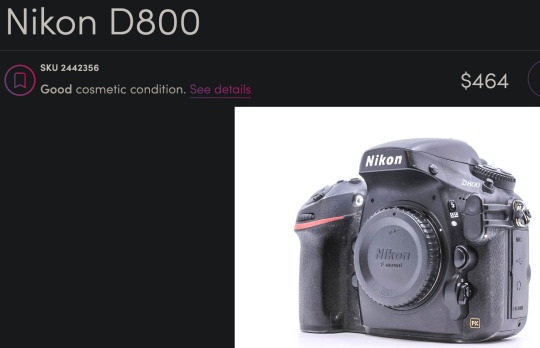
This is a newer camera than the 6D with more megapixels (36) and a better sensor. It also has a more modern autofocus system and about 3 more stops of dynamic range which can come in handy for landscapes. This is an incredible camera for this price.
APS-C DSLR Camera Bodies
If you aren't sure you want to commit to this hobby, you can look into a Canon APS-C sensor body like the Canon Rebels and Canon 60D through 90D models and get good results.
And there are many Nikon DX APS-C bodies that would be great starter cameras as well. If you get a Nikon, you'd have an upgrade path to the D800 if you get hooked by the photography bug. I would miss a few very special Canon lenses like the 100mm f/2.8L macro and the 400mm f/5.6 telephoto but I'm sure I could figure out some reasonable Nikon alternatives that would do roughly the same thing.
Canon APS-C
There is a Canon 60D for $139 right now that would be perfectly adequate for landscape work on a tripod.
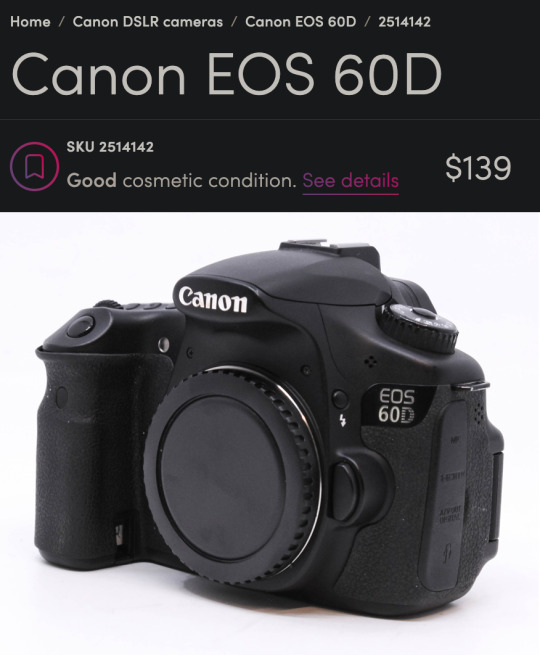
That was my first camera and I took some very nice photos with it. Only 18 megapixels but it has a very convenient flippy screen which was really helpful for a disabled photographer trying to get low angles.
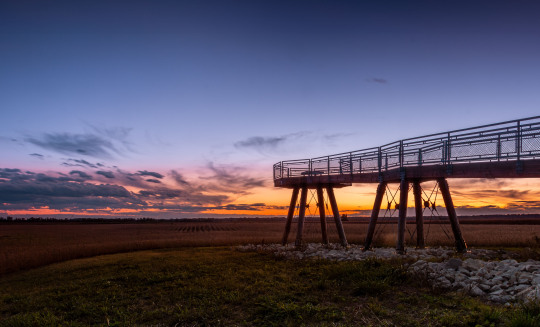
This was in 2014 and I didn't know what I was doing but that is a pretty stellar-looking sunset for a (now) $140 camera.
Nikon APS-C
And the Nikon D3400 would be a great option as well at around $184.
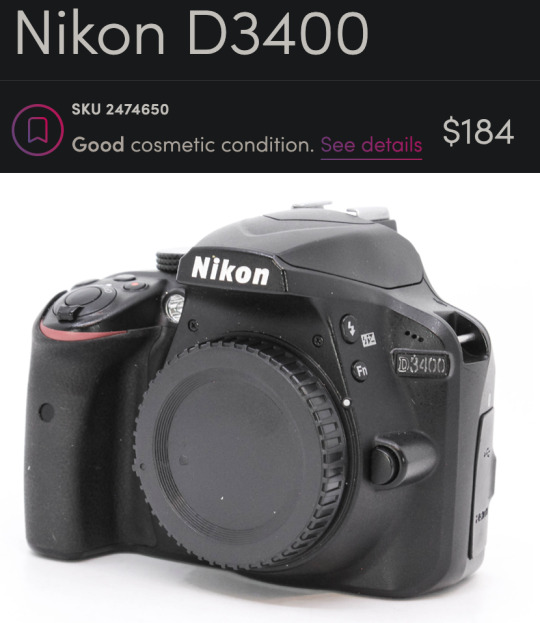
You get some extra megapixels (24) and it is a bit newer than the Canon. I get the sense that used Nikon DSLRs give you more value for your money right now but I don't have a large enough sample size to confirm that.
Full Frame DSLR Lenses
Froggie Note: I am recommending full frame lenses even if you choose an APS-C DSLR body so you have an upgrade path. But also very few purpose-built APS-C lenses had superior glass. Just remember, crop sensor APS-C cameras add ~1.5x to your focal length. So a 16-35mm will have the equivalent field of view of a 24-50mm lens. Still quite acceptable for landscapes, but you may benefit from doing panoramas more often. And if you upgrade to full frame down the road, you'll already have the ideal lens.
Canon DSLR Lenses
If you get the 6D or another Canon you could pair it with the beloved-by-landscapists Canon 16-35mm f/4L.
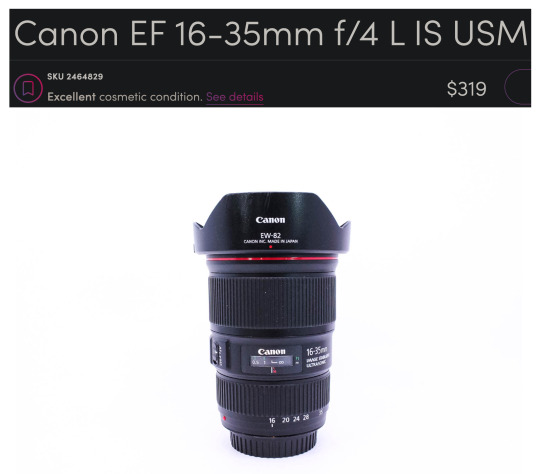
Honestly, it is blowing my mind you can get that combo for under $600. Me from 12 years ago is super jealous right now.
If you are worried you might need something to work in lower light and still want a zoom, the f/2.8L starts at around $434.
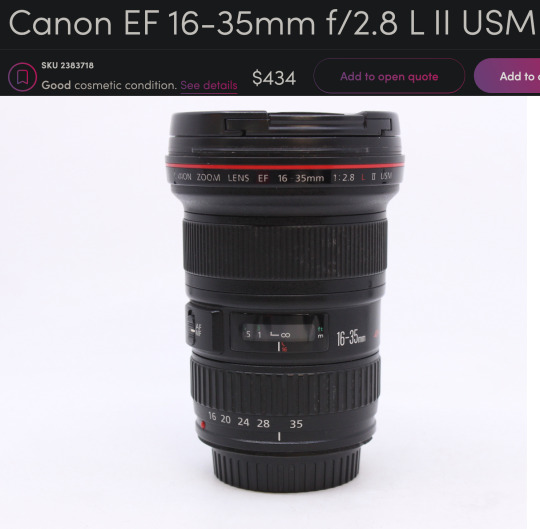
This might be the most famous landscape lens of all time. Kinda boggles the mind how many gorgeous vistas this thing has captured the light of.
If you can live without the zoom, you could get a much sharper prime lens that can also be used in even lower light. A used Sigma 24mm f/1.4 Art lens is $439 would be a fantastic option.

24mm is still a very good focal length for landscapes and the sharpness of this lens lends well to panoramic stitches. Seriously, these art lens are so freaking sharp. Although 35mm is typically preferred for most street photography, I think this would do great for that purpose as well. It couldn't do close up portraits, but 3/4 and full body portraits would look great. I also love this focal length for doggos. It enlarges their heads a bit which enhances adorable-ness.
Though I probably wouldn't recommend the 24mm on APS-C for landscapes as it would put you near a 40mm full frame equivalent field of view.
Nikon DSLR Lenses
And on the Nikon side of things you could get the Nikkor 16-35mm f/4 for $399.
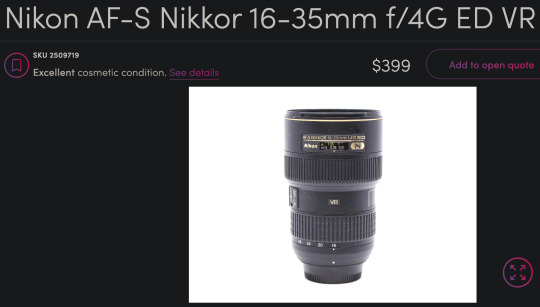
This is a great lens too. Very comparable to the Canon L glass. And paired with that D800 you would have a better shooting experience than with the 6D if it fits within your budget.
It's a little harder to find, but you can also get that same Sigma 24mm f/1.4 Art lens for Nikon at around $528 used on Amazon and in the $400 range on KEH and MPB when it is available.
The older and softer Nikkor 28mm f/1.8 is a little more affordable and easier to find.
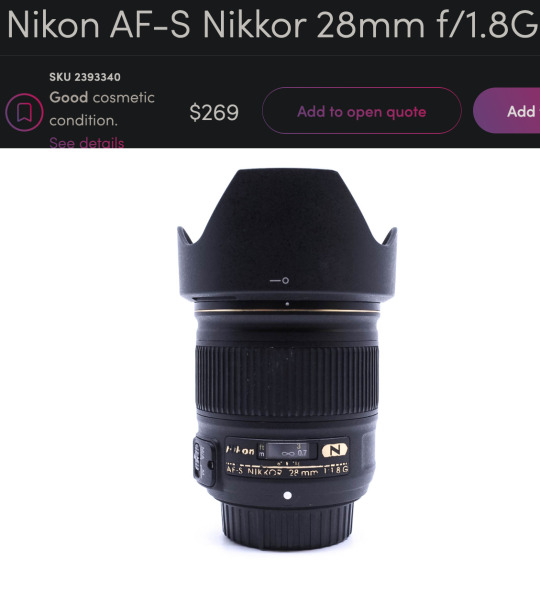
What if you are not a dentist but are willing to save up for something a little nicer?
Enter the world of...
Mirrorless Camera Systems
Sony currently has my favorite ecosystem of mirrorless cameras and lenses and they are consistently ahead of the other brands as far as technology and features. In fact, many other manufacturers use Sony sensors. They literally supply their competition with their own tech. They are also pretty good about updating firmware—even with older models. So I feel like Sony has a lot of future-proofing advantages over other brands. Sony has a great selection of 3rd party lenses like Sigma, Tamron, Viltrox, Laowa, Samyang, etc. These lenses often have nearly the same optical quality as Sony's G Master lenses at a fraction of the price.
Full Frame Mirrorless
Currently, I think the best value full frame mirrorless camera for landscapes would be the Sony a7R III.
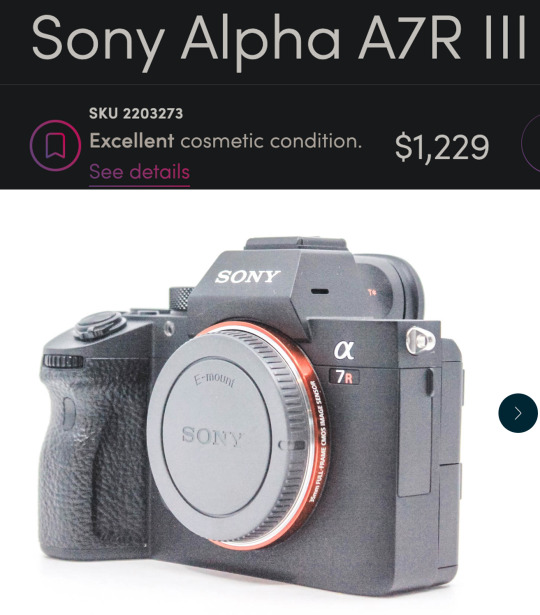
This is very nearly a top-of-the-line landscape camera for a little over $1200.
That might sound like a lot, but I want to be clear...
This isn't just decent. This isn't "good enough." This is a spectacular professional grade full frame camera.
10 years ago you could spend $6500 for a *worse* camera. 5 years ago you could spend $3000 for a *worse* camera.
It can do every genre of photography except for maybe fast paced sports/action. It has an amazing 42 megapixels—which are not necessary but they do make editing and printing a lot less of a headache. The file sizes can get a little big, but storage is a lot cheaper than it used to be.
Oh, and it can be used for professional quality 4K video work too.
The a7R III comes with all of the modern bells and whistles including in-body stabilization (IBIS) so you can handhold at very slow shutter speeds. It has one of the best autofocus systems—complete with eye tracking. But not just human eyes! Dog eyes. Cat eyes. Bird eyes. If it has an eye, the Sony can probably lock focus on it. And it has an admirable 10 fps burst shooting mode.
APS-C Mirrorless
If you want to enter the Sony ecosystem but can't afford full frame quite yet, you could do the a6400 for about $600.
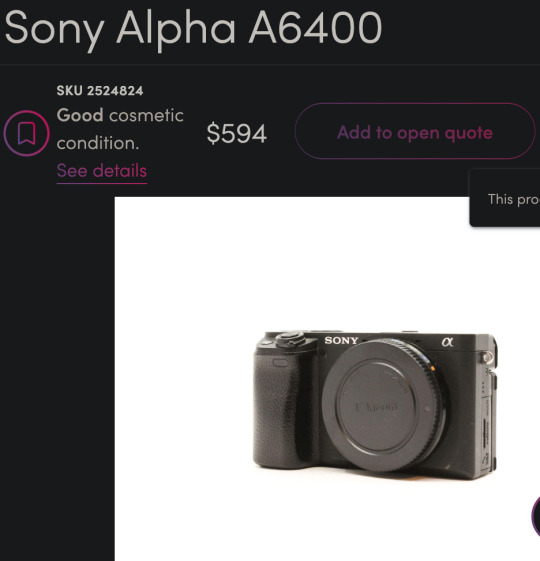
You still get the eye-tracking and the in-body stabilization, but you will lose some image quality at higher ISOs due to the smaller sensor size. However, you can get the same full frame E-mount lenses for it and upgrade to a bigger sensor later on and not have to buy new lenses.
Mirrorless Landscape Lenses
I think a good value landscape lens would be the very impressive Tamron 20-40mm f/2.8.
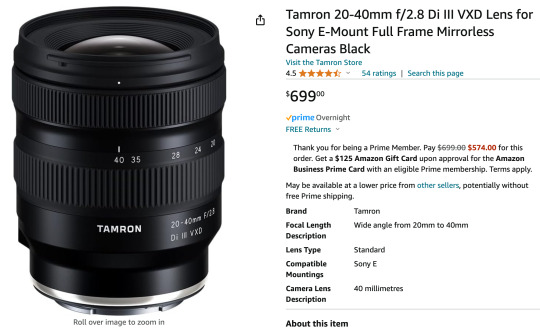
This is a newer lens so there aren't many deals on used options yet. But this is still a great price for the quality and versatility you get. You will never regret spending a little more on glass.
The 20mm range can fit an entire cityscape in the frame without needing to do a panorama. But if you zoom to 40mm and mount the camera vertically, you could stitch together several photos to get well over the 100 megapixel range.
Also, the 40mm focal range is long enough to do street photography and even head & shoulder portraits. The wide f/2.8 aperture combined with the high-ISO friendly full frame sensor and in-body stabilization means you can shoot in very low light without a tripod. You can also get some great pictures of stars if you travel to someplace with minimal light pollution.
The cheapest landscape zoom lens I could find was the Sony 16-35mm f/4 at $384.
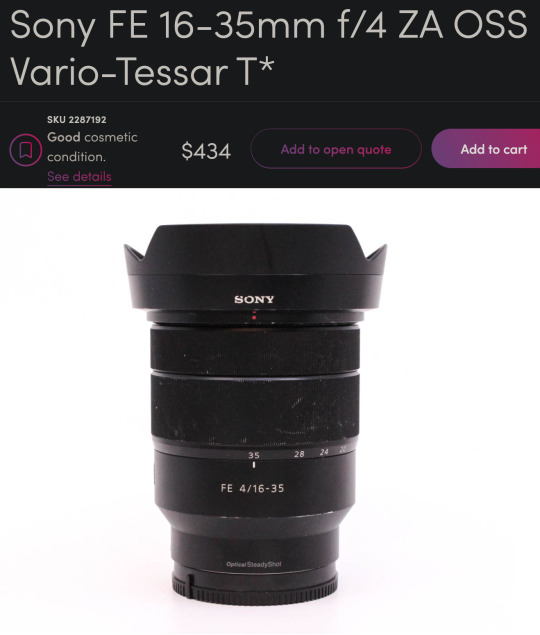
It's one of Sony's older lenses and may not take advantage of all of the a7R III's pixels, but it would be a good option to get you started in this system and upgrade the lens later on.
Mirrorless Prime Lenses
Zoom lenses are great but you have to spend more to get tolerable quality. Kit zooms can be softer than even the tiny plastic lenses on your phone. So a great way to stretch your budget is to get multiple fixed focal length "prime" lenses. Primes can be built inexpensively while still having good low light performance and decent sharpness.
For instance, you could start with something like the Tamron 20mm f/2.8 for $175. And if you want to do more than landscapes you could add the Sony 50mm f/1.8 for $170 later on. Cheap primes will outperform any of those mediocre kit zoom lenses in that same price range. You lose some versatility and have to deal with the pain of changing lenses or zooming with your feet, but sometimes a tight budget demands a little pain.
There is also a higher quality 3rd party wide angle prime lens that is very popular right now. The Viltrox 16mm f/1.8 is only $549 and the reviews say it has similar quality to lenses 3 times its price.
If you have to choose between a better camera body or a better lens, a good lens will help your photos more than a fancy camera body.
Froggie Note: These are examples. You should always do your own research before making a major technological purchase. This post could be a year old by the time you see it and there could be new stuff that is better. But all of the principles I tried to convey should hopefully guide you to a good decision. Also, feel free to message me if you want to ask about specific gear you are considering purchasing.
More Resources
This is my Encyclopedia of Lens Terms which is a helpful primer in understanding all of the wonderful and different lens options available on ILCs.
This is my buying guide for low budget used DSLRs. Similar to this post but less geared toward landscapes.
And this guide for getting decent landscape photos with any camera.
This is a free tutorial that teaches you everything you need to get started with an ILC system.
youtube
And this free tutorial by Karl Taylor is quite good as well.
70 notes
·
View notes
Note
Hi Froggy,
I hope you've been well! I wanted to reach out and first say that you inspired me many years ago to rescue a corgi! She was a grump, I think she may have taken her name (Elphaba) too literally. She recently crossed the rainbow bridge, but she was such fun and a joy. I hope our pups are playing together, somewhere peaceful.
I have a question unrelated to stumpy Corgis. I'm a veteran birth doula and an aspiring birth photographer! I've been trying to research cameras, lenses, and all sorts of technical stuff. I'm leaving towards purchasing the new Nikon ZF, because of the purported low-light capabilities.
Lenses are throwing me completely.
Do you have any guidance or resources to help a newbie like myself? Not really looking for an in-depth answer (I know how complicated things can get), but maybe a general push in the right direction?
If you don't want or can't answer, no hard feelings! I enjoy just seeing your posts on my dash and I hope the rest of your year is amazing and calm!-Steph
(continued...)
My budget is pretty flexible, since I am an independent contractor the expense would be tallied towards my taxes. But that being said, maybe $1-3k? I know it's important to invest more into lenses!
Usually, I am in a hospital, and lighting is extremely variable. I would be shooting mostly in low-light before baby is born. During delivery and after there is usually a spotlight or fluorescent lighting. The low lighting is exactly why I was looking at the new ZF, but if you have suggestions on that too I'm happy to hear them!
It's very cramped when the baby is born, most medical and support staff are clustered around the laboring person.
Warning! A lot of birth photos will have baby crowning or blood. It's a messy business, so I don't want to trigger you if you're sensitive to those sorts of images.
I will not be able to be directly next to the laboring parent, more than likely I'll be a few feet away, possibly behind the parents or standing on a stool.
After the baby is born, I'll be able to get closer to both parents and baby!
Here's a portfolio that is close to what I would like to provide (once again TW for blood and crowning):
https://www.sarahginderphotography.com/birth-photography-north-new-jersey
I cannot thank you enough for any help or advice, this whole endeavor is like learning a new language!
----------------------------
Note from Future Froggie...
I went way overboard on this response, as usual. I have decided I'm going to break it up into 3 parts.
First, an encyclopedia of lens terminology.
Second, a camera and lens buying guide.
Third, practical advice for shooting in cramped rooms with tricky lighting conditions.
While this will be geared towards the original ask, I think this could be helpful to a lot of people. So, let's learn about lenses!
--------------------------
Lenses throw everybody, just because there are so many options. It can be overwhelming to look at a picture like this and wonder what will suit you best.

It's a lot of pressure too, because lenses are more important than the camera in a lot of ways. Interchangeable lenses are probably the biggest advantage big cameras have over smartphones these days.
But I think I can help get you up to speed.
The following terms are photospeak you might hear in camera and lens reviews and if you aren't familiar with them, it can make it difficult to figure out what camera and lens to purchase.
I tried to put these in an order that makes sense, but some terms relate to other terms and you may have to read the list twice to make sure you understand how everything mushes together.
Froggie's Encyclopedia of Lens Terms
Lens Mount
Every camera has a specific lens mount. Sony calls theirs the E Mount. Nikon has the F Mount (older) and the Z Mount (mirrorless). So you need to make sure the lens you are looking at is compatible with the mount on your camera.
Mirrorless cameras all upgraded to a mount with a "short flange distance." Going without a mirror allows the lenses to be closer to the sensor.
Long story short... Short flange distance = easier lens design = sharper/lighter lenses.
However, if you want to use older DSLR lenses, there are adapters for Nikon and Canon that allow you to do that.
Aperture
"Aperture" is an opening at the front of the lens. It gets bigger to let in more light or smaller to restrict light.
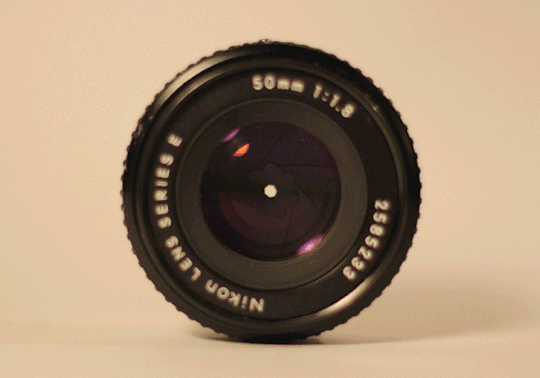
Wider apertures have a shallower depth of field, causing blurry foregrounds and backgrounds outside the plane of focus. Smaller apertures expand the focus area to keep more stuff from being blurry, but they let in much less light and are difficult to use in dark environments.
Aperture can be a creative decision or it can be a technical decision or it can be a mix of both. If you need a blurry background, use a wider aperture. If you need everything in focus, use a smaller aperture. If you need more light in a dark scene, open it up.
F-stop
"F-stop" is a number representing how big the aperture is. A lower number is a bigger hole. Higher number is a smaller hole. It is helpful to memorize f-stops as they are not easily divisible. Cameras generally allow third stops, half stops, and full stops.
These are all a "full stop" apart.

Stop Down/Open Up
When someone says to "stop down" a lens, they are telling you to make the aperture smaller or use a higher f-stop number.
If they say to "open up" they are saying to make the hole bigger or lower the f-stop number.
Depth of Field (DoF)
Depth of field refers to how much of the photo is in focus. Things in front of the plane of focus will get blurrier and blurrier and things behind the plane of focus will get blurrier and blurrier. A shallow depth of field means only a tiny sliver of your image will be in focus. A deep depth of field means almost everything will be in focus.
The wider the aperture, the shallower the depth of field.
The smaller the aperture, the deeper the depth of field.
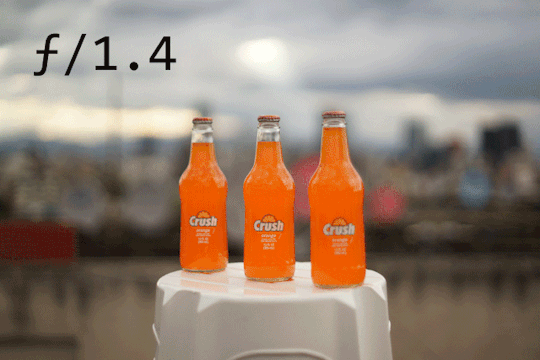
Focal Plane or Plane of Focus
The focal plane is the sharpest point within the depth of field. You can imagine an imaginary section of 3D space where things within the depth of field are sharp and things outside are blurry. The farther away from the focal plane, the blurrier they will get. But the focal plane is not always dead center of the depth of field.
Typically, at close distances, things will be sharp half in front of where you focused and half behind where you focused. As things get farther away, that changes to more 1/3 in front and 2/3 behind. The ratio changes even more at greater distances, but the 50-50 and 1/3-2/3 ratios are typically what photographers try to remember.
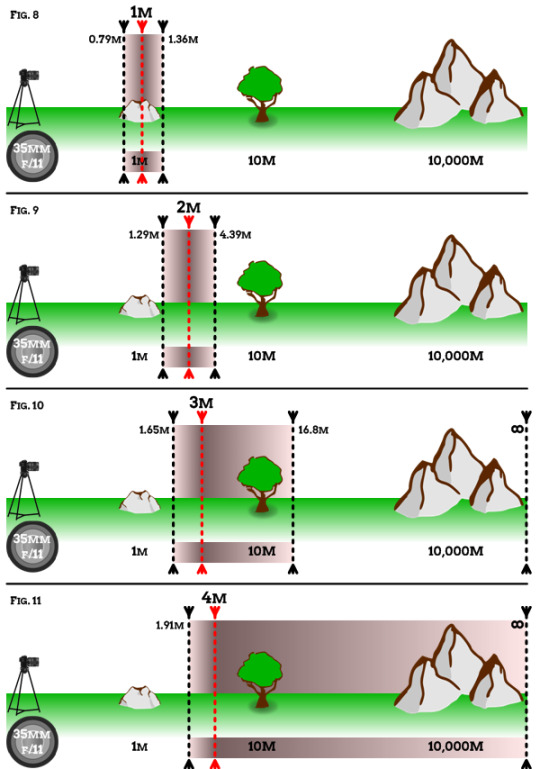
Shallow Depth of Field
The focal plane is something you need to be very aware of at close distances with a wide aperture—as the depth of field can end up as a tiny sliver.
Let's say you are only a few feet away from a baby and you have the aperture set at f/1.2. You focus on the nearest baby eye, and then you notice its ears and nose are out of focus.
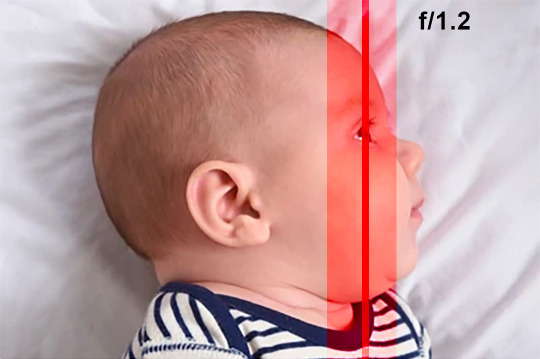
The plane of focus and shallow depth of field are causing this issue. This might be a worthy compromise if you are in a dark room and your ISO is very high and you are worried about too much noise.
However, if you can use a flash or some kind of lighting, you can stop down your lens and increase that depth of field around the focal plane.
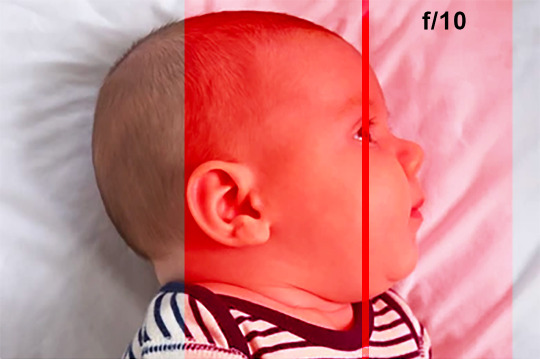
Bokeh
Bokeh is the quality of the blurriness. Some people are more obsessed with how good the blurry parts of the photo are more so than the in focus parts. Bokeh is typically judged by "bokeh balls" which are just out-of-focus lights in the background. While I like attractive bokeh balls as much as the next photographer, I will admit this is one of the sillier aspects of photography.

Field of View (FoV)/Angle of View
This is how much stuff you can fit in frame at a given distance. Wide angle lenses can fit more stuff in at a shorter distance and telephoto lenses can fill the frame with stuff that is farther away. The focal length of the lens determines the field of view. The focal length is designated by millimeters and the field of view by degrees.

Focal Length
Technically, this is "the distance between the lens's optical center and the camera's sensor."
In simpler terms, this is how you determine the field of view of a given lens.
A short focal length, like 10mm, will have a wider field of view. You have to be very close to your subject to fill the frame with them.
And a longer focal length, like 500mm, will allow you to fill the frame with your subject from farther distances.
Typically all lenses are designated by their focal length. If someone says, "Hand me the 50" they mean a 50mm lens.
35mm Equivalent
Not every camera has the same sized sensor. So when we talk about lenses, we need a reference to help us understand how a given lens will behave. A 50mm f/2.8 lens does not have the same field of view or depth of field when placed on different sensors. So, we need a standard for comparison.
The standard that is used is the "full frame" sensor which is roughly the same size as a 35mm piece of film.
Anything smaller is considered a "cropped sensor."

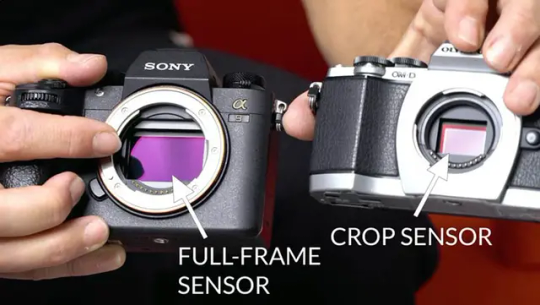
Those cropped sensor cameras have a "crop factor"—a simple multiplier that helps you understand how lenses compare. And when you use this multiplier it tells you the "35mm equivalent."
Confused yet? Yeah, sorry, it would be easier if camera manufacturers chose metrics that didn't change depending on the sensor, but this allows them to make their cameras and lenses seem more impressive in the marketing.
There are two main cropped sensors for ILCs. (Interchangeable lens cameras.) APS-C and Micro Four Thirds. They have a "crop factor" of 1.5x and 2x respectively. The Micro 4/3 sensor is half the size of Full Frame, therefore it has a 2x crop factor. And when you apply this crop factor to the aperture and focal length you can determine how a lens will behave.
For example, a 50mm f/2.8 lens on a micro 4/3 sensor would behave the same as a 100mm f/5.6 lens on a full frame—as 100mm is 2x 50mm and f/5.6 is 2 stops above f/2.8.
As you can see, the Micro 4/3 lens is not going to do as well in low light. The iPhone boasts an aperture of f/1.8 on its main lens, but when you figure out the 35mm equivalent, it's more like an f/8 lens.
I went to all the effort to explain this because it demonstrates that larger sensors allow you to work in cramped spaces with less light. If you want to use a 50mm in a hospital room, you probably can on a full frame. But on a Micro 4/3 you might need to be out in the hall because your lens is acting like it is 100mm. So the Zf would be a good choice in this regard.
Camera Shake
This is the bad kind of blurry. Humans are not tripods, so when you are handholding a lens, you need to make sure your shutter speed is fast enough to freeze the action of your image. Camera shake is very easy to control on wide angle lenses and very difficult to manage with telephoto lenses.
Reciprocal Rule
The reciprocal rule states that in order to get sharp photos without blurry camera shake, you must set your shutter speed to 1 over twice the focal length of your lens. So if you have a 100mm lens, you need to set your shutter speed at 1/200 to be safe.
This rule breaks down at a shutter speed of 1/50 if there is anything moving in your image. So if a dog is running or a car is driving by, it will have a motion trail, but at least it won't be due to your shaky hands.
Image Stabilization
This is a feature some lenses have that helps reduce camera shake. Image stabilization can counteract shaky hands and let you get sharp photos with a much slower shutter speed. Newer cameras have sensor stabilization which does the same thing. And if you pair up a stabilized sensor with a stabilized lens, it is almost as effective as using a tripod.
Stabilization is measured in stops. You might hear a lens has 4 stops of stabilization. That means you can handhold the lens and not get camera shake with a shutter speed 4 stops below the reciprocal rule. So for that 100mm lens, that 1/200 becomes roughly 1/12. And if your sensor has 4 stops, you could handhold a shot for nearly a second without any shake.
However, at shutter speeds that slow, if anything in the frame is moving, they will probably have motion blur. But for still life scenes, or maybe a sleeping baby, this can be very handy if you don't have a tripod with you.
If being able to handhold at lower shutter speeds seems important, then you might want to seek out a lens with stabilization and pair it to a camera with sensor stabilization for maximum stable-osity.
Lens Compression
Lens compression is kind of a myth, but I think we still call it compression because it is easier to explain to beginners than optical physics. The lens doesn't really compress anything, it's actually a matter of distance and the aforementioned physics. But I'm going to go with the easy explanation for now.
Lens compression is a phenomenon seen with different focal lengths. If you take a photo with a 500mm lens, the background will seem to compress with the foreground. Thus objects in the background will seem much larger in size.
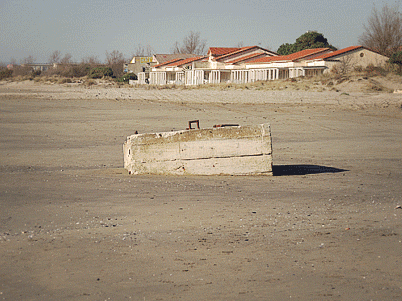
This also happens with faces.
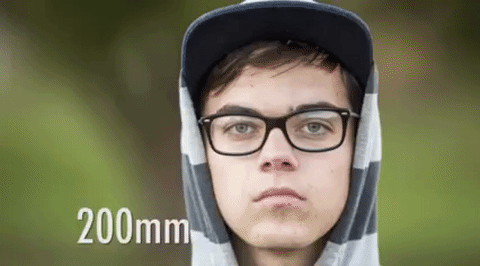
Wider lenses exaggerate distance. At 10mm, the lens would only be a few inches away from someone's face.
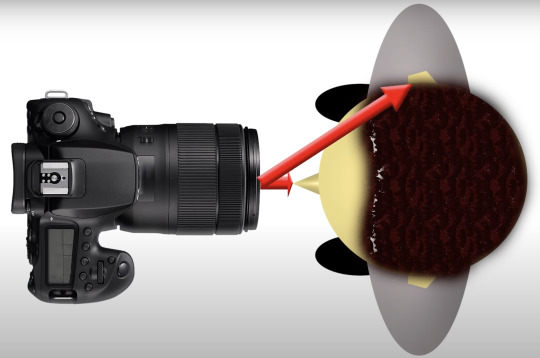
From the lens's point of view, the ears are several times farther away from the lens than the tip of the nose. So the lens is like, "Your ears are really far away! And far away things are really small, right?" So the lens gives us a big nose and small ears and makes us look a bit alien.
But at 100mm, the lens will be several yards away.

From this perspective, the lens feels like your ears and your nose are nearly the same distance away. And the lens is now like, "Things that are the same distance away do not get bigger or smaller." The lens seems to compress or flatten the face, causing a more flattering appearance in the image.
Minimum focus distance
This is sometimes called the working distance. This is how close you can get to your subject while maintaining focus. If you get too close, your camera will just hunt and freak out perpetually until you back up and it can lock on again. This isn't always advertised prominently for lenses, so you need to make sure the lens will be able to focus in the space you plan to use it.
Extension Tubes
Sometimes called "macro extension tubes." These are spacers you put between your camera and lens to decrease the minimum focus distance. In some cases you can even turn a normal lens into a macro lens. These tubes are able to stack and the more you put on, the more into the macro realm you can go. They come in smart and dumb versions. The dumb ones require you to manual focus whereas the smart ones can still use the autofocus system. I highly recommend the smart ones, as they are not too much more expensive.
Lens Imperfections
There are a few imperfections that can plague all lenses and their quality is sometimes judged by how well they mitigate those imperfections. Here are some of those attributes.
Lens Distortion
As lenses get wider, they allow a larger field of view by accepting light rays that are coming from the side of your lens. Let's look at this image again.

Your lens then has to correct those rays and send them to a square, flat sensor. If you look at the 180 degree fisheye, that entire arc has to be flattened and made square. And as good as optical engineering has become, the wider the lens, the harder it is to keep the image from distorting.
This is typically called "barrel distortion." Minor distortion can actually be corrected in editing software. Every lens has correction algorithms. Though sometimes it is best to embrace the distortion, like on a fisheye lens. Make the distortion a feature and not a bug.
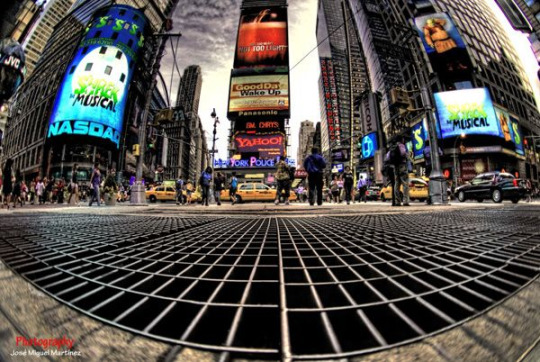
Chromatic Aberration
This is the fancy name for color fringing. This is a defect in the lens that cause false colors to contaminate certain objects in a photo. Typically this happens around dark skinny things against a bright background, such as tree branches.

Modern lenses have nearly eliminated this, except for the super cheap models, but if you do end up with fringing, this can be easily corrected in Lightroom or Photoshop. And many lenses even have that correction built in and all you have to do is check a box.
Sharpness
You might not think of sharpness as an optical flaw, but no lens is perfectly sharp. And the quest to make a perfectly sharp lens involves engineering those optical flaws to a minimum.
A "sharp lens" is one with incredible fidelity. Even zoomed in beyond 100%, sharp lenses will show great detail. If you can't get close to the subject and need to crop your photo later, having a sharp lens can make up for the loss in resolution—as you can upscale without much loss in quality. If you plan to make large high quality prints, a sharp lens will help more than tons of megapixels.
That said, if you truly want to get the most out of a high megapixel camera, a sharp lens comes in handy here too. A smartphone may boast in the marketing as having 200 megapixels, but it has a tiny plastic lens. So even though it technically has 200 megapixels on the sensor, the lens will give it the equivalent of maybe 8-10 megapixels worth of detail. People forget, the lens has a resolution as well, and if the lens cannot resolve 200 megapixels, you aren't going to get a 200 megapixel image.
A sharp lens will allow for more detail than higher megapixels. In some cases you need to double or triple the number of pixels to see an increase in detail. Whereas you can put a super sharp lens on a 12 megapixel camera and blow any smartphone out of the water.
And if you put a sharp lens on a 50 megapixel camera, you can almost see into skin pores.
So... sharp = more detail. And more detail gives you greater cropping power for when you can't get close to babies.
Now, I am obligated to say that some photo nerds chase sharpness as if it is some holy grail. They need the sharpest lens so all of their pixels are perfect at 100% zoom even though no one ever looks at an image that close. There are amazing photos that have been blurry. There are amazing photos taken with 50 year old vintage glass. Sharpness is just another tool. If you need to crop. If you need to upscale. If you need to print large... it is a great help. But nearly every lens made for a modern mirrorless camera is "sharp" to some degree.
So, if you need extra sharpness for certain situations, do your research and find a lens that is sharp as can be. But sharpness should be like 8th on the list of priorities.
Soft Lens
A "soft" lens is how a non-sharp lens is referred to. Most modern optics for mirrorless cameras have some degree of sharposity.
Sharpitude.
Sharp...ness.
So you don't need to worry too much about getting a detrimentally soft lens unless you go super duper budget. This is why I usually recommend people skip the "kit lens" unless they absolutely can't afford anything better.
Though sometimes people purposely get vintage lenses because they don't like sharpness and prefer the "character" of older lenses. The imperfections can achieve a different artistic goal. Though this can also be achieved through lens filters... or Vaseline.
I'm looking at you, Barbara Walters.

Sharpness at the Corners
When I read that in my head just now I said it the same way I do "Panic! at the Disco."
Engineers will prioritize sharpness at the center of the lens since that is where most of the interesting stuff tends to be. But also, the light rays at the center tend to be the most parallel as they head to the sensor, so they don't need as much correction. The rays coming from the sides have to be bent and manipulated to correct for distortion, so keeping things sharp at the corners can be a challenge.
Now, knowing that, and knowing how the aperture works, you can infer that when you stop down your lens and make the hole smaller, all of the light rays are constricted to a smaller area. This makes them easier for your lens to deal with, so if a lens has problems with corner sharpness, you can usually stop down to improve this. So if a lens is soft at the corners at f/1.8, you might be able to go to f/2 or f/4 to get better results.
Vignetting
Vignetting is a circular area of darkness at the perimeter of your photo. This is another side effect caused by the same things as soft corners. When correcting those non-parallel light rays, it causes them to travel an ever so slightly farther distance getting to your sensor. And the inverse square law tells us that light becomes dimmer as it travels longer distances.
This is very easy to correct. Usually your camera has a setting to correct vignetting if you are outputting JPEG files. And if you are shooting RAW photos, your editing software should have a check box to fix the vignetting—usually the same one that fixes chromatic aberration. This is usually called "lens correction" in most menus.
Also, same as with corner sharpness, stopping down your lens will usually fix this optically rather than with software algorithms.
Contrast
Contrast is probably the most important attribute to determine lens quality. Good contrast can make a soft lens look good. But lens contrast is not always consistent. It can get better or worse depending on the lighting in your scene.
The best way to test the contrast of a lens is to take a picture of something that is backlit. A person with the sun behind them is a great indicator. If they have no light on them, the person should fall into inky darkness. But if a lens has poor contrast, they will seem like a faded gray.
Focus Breathing
Focus breathing is a phenomenon where your focal length changes depending on how far away your subject is. It's usually not a big deal and most people don't even notice it, but if you ever do video, it can cause a few headaches. Some people can get annoyed because they feel they aren't getting the advertised focal length on the lens they bought. Like, if you get a 300mm lens and it only goes to 250mm for things super far away, that can be annoying.
This video explains it in detail.
youtube
Lens Types
Prime Lens
A "prime lens" has a fixed focal length and cannot be zoomed. Typically prime lenses are "faster" (wider max aperture) and sharper. Weirdly they can be very inexpensive or the most expensive. They can be extremely lightweight or weigh a ton. And if you want the sharpest lens possible or the fastest lens possible or both, it will be expensive and heavy.
Having at least one fast prime is usually recommended for any professional photographer.
Zoom Lens
A "zoom lens" allows you to zoom. Obviously. But there are few that go below an aperture of f/2.8, so less light gathering and you sacrifice a bit of sharpness. However, if you don't know how much space you will have to work with, the flexibility of a zoom can be invaluable.
Be warned, while a cheap prime lens can still take fairly good photos, cheap zooms are usually pretty terrible. There are plenty of reasonably priced zoom lenses to choose from, but if the price seems too good to be true, I would trust that intinct.
Wide Angle Lens
A "wide angle lens" is any focal length below 35mm. Wider focal lengths allow you to get more stuff in the photo at shorter distances. A theme you might notice with photography is that every benefit has a compromise or consequence to go with it. Wide angle lenses are wonderful if you are in a cramped space. They also make it easy to keep everything in focus. But as you go wider, distances become exaggerated and barrel distortion becomes more pronounced and harder to correct.
Things that are close to the lens seem huge and things farther away seem tiny. One trick to remember is things in the center of the frame will be less affected by distortion. Something to take into account when taking those smartphone selfies.

If you look, the ball looks huge in frame because it was only a few inches from the lens. Otis was literally smaller in frame than the ball despite only being about 2 feet away. However, he doesn't look all stretchy like the ball because he is centered.
Standard Lens
A "standard" or "normal lens" represents about the same field of view as the human eye. Generally around 40mm to 55mm on a full frame camera (there is some debate on this, but close enough). This is right about where you can take pictures of faces without the unflattering side effects of wide angle.
Telephoto Lens
A "telephoto lens" allows you to stand farther away and still fill the frame with your subject. Usually lenses 200mm and above are considered telephoto. These are often heavy and expensive.
Specialty Lenses
Ultrawide
This is just an extremely wide angle lens. At this point, you just except the massive amounts of distortion and embrace it. These lenses are extremely fun.
Medium Telephoto
These are sometimes called "portrait" lenses as well. They are a little more tele than standard and not quite tele enough for long distance photography. Usually in the 70-200mm range. This is the focal range that allows you to still be close to your subject but you are far enough away to get extra flattering lens compression on faces.
Superzoom Lens
A "superzoom" has an extremely large focal range. It can go from very wide to very telephoto. These are usually not wonderful lenses, although they have improved on mirrorless cameras in recent years. There are a few that could even be used professionally now. But most are just a huge mediocre compromise for vacation pix.
The cheap ones aren't fast, they aren't sharp, and every time you zoom people think your camera is having an erection.
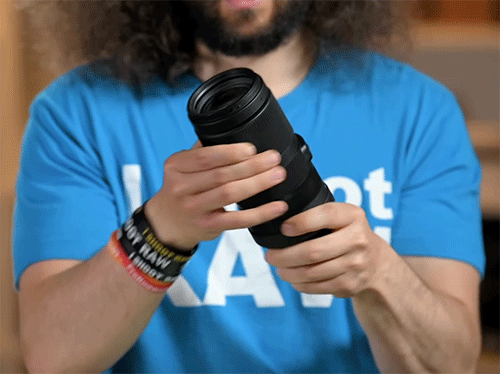
If you are traveling and you have no idea what you might be photographing and carrying around a bunch of lenses is impractical, these have utility. But the larger the focal range, the more mediocre they get. Typically if the zoom range exceeds ~150mm you will start noticing that mediocrity. So a 70-200mm can be fantastic. But an 18-300mm will be very mid.
Macro
A macro lens is any lens that has 1x or more magnification. 1x magnification is a designation that relates the sensor size to how much of the subject fills the frame of your image. For 1x, that ratio should be 1:1.
So if you imagine a quarter lying on top of an image sensor, that's how big the quarter should be in your photo. 2x magnification would be like if a quarter doubled in size and you laid it on top of the image sensor. And so on.
Beware of lenses claiming to be macro and really only having a short working distance. 0.5x is not macro, but is sometimes advertised as so.
Tilt Shift Lens
This is a very niche lens. Most people know of it from the photos that make everyone look like they are in a miniature land.
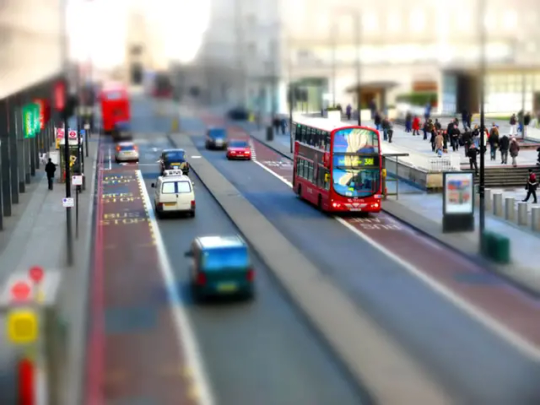
For every other lens, the focal plane is perpendicular. If you move the camera at an angle, the focal plane will match that movement. So what the tilt shift lens allows you to do is angle the focal plane so your depth of field goes in bonkers directions.
Product photographers love this because you can take a photo of an array of products from a 45 degree angle and keep everything in focus.

This image would be impossible to maintain complete focus of all the objects without a tilt shift lens.

In this example, without tilting the lens, the tip of the multitool is out of focus.

And now you can see the camera hasn't moved, but the lens is at a steeper angle. And you'll also notice the entire tool is in focus.
But wait, there's more! Did you forget about the shifting? Architectual photographers can use the shift function of the lens to correct perspective distortion and keep buildings looking straight.

Will this lens help in the photographing of infants?
Probably not.
But I bet you thought it was cool and are glad I included it.
Recommended Essential Lenses
I didn't know what to call this section. These are just the collection of lenses most photographers will try to acquire as they build out their kit.
Nifty Fifty
This is probably the first lens everyone should buy. Almost every brand has their own version. It is an inexpensive 50mm lens with a sub f/2 aperture. Canon's Nifty Fifty or "Plastic Fantastic" is probably the most famous example. It is only $125 and has an f/1.8 aperture.
This lens may not be the sharpest and it might have a lot of plastic-y, cheap feeling parts, but it is a wonderful way to get started with photography. You can use the wide aperture to experiment with bokeh and shallow depth of field. And the 50mm focal length is probably one of the most versatile. Not too wide, so people look normal, and not too tele, so you aren't a mile away from your subjects.
The Holy Trinity
The "Holy Trinity" is meant to describe the 3 lenses that can handle nearly every photographic task while maintaining professional quality results. Typically these lenses are all f/2.8 and are high quality zoom lenses. The 16-35mm, the 24-70mm, and the 70-200mm.
Most photographers can accomplish just about any task with these lenses in their bag.
Froggie's Holy Hexagon
That said, if I had an unlimited budget I would actually have 6 lenses to cover everything. Beyond the Holy Trinity, I would get a fast prime, an ultrawide, and a macro lens.
A fast prime can see in the dark and has more background blur. The nifty fifty would work great for this.
An ultrawide is one of the most fun lenses you will ever use, even if it distorts everything to a crazy degree and isn't useful very often. It is great for breaking you out of photographic ruts and can really get the creative juices flowing.

And a macro lens is not just useful for making tiny things big. It also allows you to focus at any distance. Sometimes you just need to get a tad bit closer than your other lenses will allow. Macro lenses are also pretty great portrait lenses and can serve multiple functions.

And if anyone is interested in sports or wildlife photos, a nice telephoto lens might be a seventh lens to consider.
I think that is the end of part 1.
I hope this was helpful. And I look forward to posting part 2 soon.
89 notes
·
View notes
Text
Touching is Good: A Retrospective
My trusty Nintendo 3DS, which has held out since I was gifted it for my 15th birthday, has turned one decade old with my 25th birthday this past November. Given new life with custom firmware and nds-bootstrap via TWiLightMenu, the 3DS is stellar for visiting any past handheld title or console title up to (and somewhat including) the N64. (Quick plug for the CFW/hacking community for the less popular PS Vita, too, which has accomplished some pretty crazy-cool stuff this last year.) I use my 3DS more often than I use my Nintendo Switch most weeks.
The Nintendo DS (minus the three) launched in late 2004. The second display and stylus support were novel tools for developers to experiment with, and the NDS is best remembered for its robust catalogue of RPGs and visual novels. Where it lacked in power, narrative-focused games flourished under its technical limitations.
That being said, while browsing the ROM archives on Vimm's Lair to pick up some titles, I was reminded of what an interesting era the mid-to-late 2000s were for games. While Sony and Microsoft were fighting over the "core gamer" demographic, who had outgrown Nintendo mascots, Nintendo led a series of wildly successful marketing campaigns for its hardware after the light failure of the Gamecube, where the Nintendo DS and then the Wii were targeted at...everyone else.

[Image source. Image description in alt text.]
If you look at ads for the DS and the Wii, you'll see that adults are featured much more prominently than children, especially women and seniors. (This did not go unnoticed, as I found this ancient relic of misogyny while looking for images for this post.) A Nintendo handheld was already an easy sell to parents with small children (though I think it's also notable that ads which do focus on children often prominently feature girls. Munchlax is pretty hot...), but Nintendo's angle for the DS and Wii was that their hardware wasn't just for children. The Wii was a way to get up off the couch and to play board games with grandma. The DS was a great gadget for a working woman to keep in her pocketbook.
This worked. The Wii and DS were two of the best-selling consoles of all time. In particular, the DS's marketing campaign only worked because it came out in the perfect window of time. PDA-phone hybrids had been around since the 90s, and the Blackberry had been kicking around for a few years, but the iPhone wouldn't be introduced until 2007, and the 4G LTE standard wouldn't be released until 2009. While the Blackberry was popular with businesspeople and the PDA was out of style, smartphones were luxury toys for several years; they wouldn't become near-ubiquious until the mid-2010s. I didn't get my own smartphone until probably around the same time I got my 3DS, a full handheld generation later.
Browsing the software library for the Nintendo DS and DSi with that in mind is really interesting. Many titles released for the platform serve the same purposes that would be fulfilled by simple smartphone apps less than a decade later: planners and diaries, fitness trackers, calculators, language learning and SAT prep software, even a guide to the then-most-recent version of the driver's test in the UK. These proliferated with the release of the DSi's virtual store, but they existed even with the base model. You could go to a brick-and-mortar store and buy them on physical cartridges. (You might be wondering, "Why would you bother carrying those around over just buying a Blackberry?" You can't underestimate how expensive the service bills for a smartphone were before companies realized they were the most powerful spyware tool in history.)
There was never a time where every single businesswoman in New York carried a DS Lite, but adults did buy and use them, and a not insignificant portion of the DS's software library is aimed at a casual adult audience. Another niche covered mostly by smartphone games these days—games designed to be picked up and played in short sessions on-the-go, in places like waiting rooms and subway commutes.
Nintendo made crazy bank in the seventh console generation. Publications of the time talked about a console war between Sony, Microsoft, and Nintendo, but the real battle was between the PS3 and the Xbox 360 over the gamer demographic. Nintendo was producing hardware for a niche who would quietly disappear once smartphone sales began ballooning by hundreds of millions per year over the course of the early 2010s.
After the failure of the Wii U, Nintendo's marketing strategy pivoted again, though I doubt they'll ever completely abandon their family-friendly image. Currently beat out only by the PS2 and the DS, the Nintendo Switch may very well climb to a status as the best-selling console of all time before the end of its lifespan, but the "gamer" demographic is much bigger than it was two decades ago at the dawn of the DS. As more and more devices become consolidated into the Swiss army knife the smartphone has become, consoles can only carve out a role as dedicated gaming machines.
I'm not sure we'll ever see anything like the Nintendo DS or the Wii again. I think they're worth looking back on for their uniqueness in that way as much as they are for the more celebrated parts of their libraries.
#mine#this is the first in a series of posts i have in mind on this general subject. my next one will be more entertaining i think.
32 notes
·
View notes
Text
Stay Updated with the Latest Gadgets and Devices
Explore cutting-edge technology with our in-depth reviews and updates on the latest electronics. From smartphones to smart home devices, we provide expert insights and practical buying guides.
#electronic#mobile phones#best phone 2025#style#iphone#samsung#camera#ElectronicsTips#TechReviews#SmartphoneGuide#GadgetExperts#TechCommunity
3 notes
·
View notes
Text
Nagisa Ran - If There is a Connection

Event: Kiseki ★ Blitzkrieg Autumn Live
Episode 1:

(Location: Shuuetsu Hallway)
Nagisa: …… Um, Anzu-san?
…… Ah, that’s good. I wasn’t mistaken about your name.
…… To meet you in a place like this– what are you doing here alone?
Option 1: Actually, I got lost……
(Response A)
Nagisa: …… Is that so? Then we’re in this predicament together.
…… Yes, I’m lost as well.
…… It shouldn’t be so vast. It’s far too easy to get lost in this school.
(Response B)
Nagisa: …… Where do you need to go? Hopefully it’s somewhere I can navigate to.
…… Yes, I’ll show you the way. When I visited Yumenosaki Academy, I remember you helped guide me to the student council room.
…… It’s a good thing to help and be kind to each other.
Option 2: I came to watch the lesson
(Response A)
Nagisa: …… Lesson? Whose lesson?
…… Ah, I see. Those children from Yumenosaki are here, right?
…… Sorry, I couldn’t remember it properly. I need to refresh my memory with the materials Ibara prepared for me.
(Response B)
Nagisa: …… I see. To meet you again like this, it must be fate.
…… I was a little surprised, I only recall there being those children from Trickstar being here yesterday.
…… Ah, thank you very much. I apologize for greeting you so late, it’s nice to meet you here.
Episode 2:
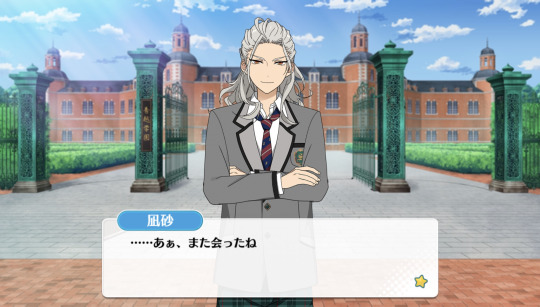
(Location: Shuuetsu Academy front gates)
Nagisa: …… Ah, we meet again.
…… Just now, who was I talking to? I'm not quite sure who that was.
…… I see… Someone you don’t know. I was approached there and asked to answer a questionnaire.
Option 1: So what happened?
(Response A)
Nagisa: …… I tried to answer it, but since I couldn’t understand what it was asking I could hardly come up with answers.
…… What is the meaning behind the questions? What is the significance of soliciting the survey in the first place? Then I asked him about what his purpose in life was…
…… For some reason, he suddenly remembered he had something to do and left.
(Response B)
Nagisa: “Fuhahahaha! What a stupid question! Bow your head and apologize!”
…… I forgot to act in character again. I forgot about it earlier, too.
…… I remembered and tried to say the same line as I just said, but it seemed to surprise him and he ran away.
Option 2: Was it a catch sale?
(Response A)
Nagisa: …… I suppose so. The purpose of what I was being asked earlier must have been to get me to buy something expensive.
…… It’s fine, though. I almost finished the questionnaire but I never signed it.
…… Ibara told me it’d be best if I didn’t sign anything unless it was for work.
(Response B)
Nagisa: …… What is a catch?
…… Huh? Did I say something funny?
…… Sorry. Without Ibara, it’s difficult to express myself properly.
Episode 3:

(Location: Shuuetsu hallway at night)
Nagisa: …… Ah– Anzu-san. Have you seen Tsumugi around here?
…… We were together not long ago but before I knew it we were separated.
…… I shouldn’t have gazed out that window.
Option 1: Should I contact him?
(Response A)
Nagisa: …… Ah, I see… I could have contacted him with a smartphone.
…… I find it troublesome to operate so I often forget it exists.
…… I have one but I’m hopeless at using it. Sorry, could you contact him for me?
(Response B)
Nagisa: …… Yes, it’d be helpful if you could do that.
…… I’m not in trouble, but it’s likely Tsumugi-kun is.
…… I hope he wasn’t left behind in the bathroom or something like that.
Option 2: What was outside the window?
(Response A)
Nagisa: …… The stars were shining beautifully tonight.
…… A romanticist? I don’t understand what makes you see me that way but when compared to Ibara I suppose you have a point.
…… It seems that we all have different values.
(Response B)
Nagisa: …… Nothing. I was just wondering if it was already nighttime.
…… Were you working so hard on your lesson that you lost track of time?
…… No, I had almost entirely free time today. Rather than losing track of time through lessons, I got lost in my excavation work.
9 notes
·
View notes
Text
Best cases for Moto G Stylus 5G (2023)
#phonecase#phonecover#smartphone#review#motorola#mobile phone accessories#shockproof#screen protector#kickstand#amazon#best#buying guides#fntcase
1 note
·
View note
Text
Artificial Intelligence and Advance Technology: Traveling through the Current Modern Era
Artificial intelligence and advanced technology have been spreading all around the world. It is now involved in the human’s daily life and can be seen every where. AI and technology is a tool that will be used for centuries and it will keep on evolving throughout our lives. Importantly, Artificial intelligence and advanced technologies is an important tool used in transportation and use by humans when they travel to make their journey easier and safer.
In the artificial intelligence and advance machinery vehicles, we have the autonomous vehicle also known as “self-driving car”. This cars are known for driving themselves without a physical driver. It has been very popular to the elites especially because, number one, only them can afford it, since it is very expensive to own an autonomous vehicle; and number two most are introverted people who doesn’t like to have another person inside the car. Most people who use this kind of cars are also known to be very fearless, trusting the robotic vehicles knowledge in bringing them to the right destination and trusting their lives with it since it has no physical driver. This vehicle are now popular in Japan and US, they use this to reduce the negative effects of freight transportation on the environment and simplifying delivery and transportation of goods, which lessens traffic and reduces financial loss.
In addition we also have the most popular technology use in all over the world - the mobile technology. This advanced technology has been the main character use in the new ways of traveling. Smartphones, laptops, tablets and smart watches is the kind of technology that can almost do it all. It can access maps that can easily be tour guides for solo travelers. It can also access to a wide range of travel agencies for easy buying and communicating. Importantly, mobile technology can now know how to recommend destinations and can locate best restaurants to visit. This is very helpful to travelers because it is now easy for destinations to find and they don’t have to worry about the legitimacy since people can now put online reviews under the posted destinations.
@therealrodthings
2 notes
·
View notes
Text
"Gen-Z Diaries: Navigating Daily Life in the Digital Age"
Looking back at my daily routine, I can't help but admit how deeply technology has embedded itself into my daily existence. As an individual living in the digital age and a part of Generation Z, I was born with technology all around me. It's just the way life has always been for me.
How I start my day
I begin my day by waking up to the sound of my smartphone's alarm. When the loud alarm on my phone goes off, it signals my brain that I should start my day. I remember my mom once described how she would set an alarm on an actual clock. But now, traditional alarm clocks are a thing of the past since smartphones have these kinds of applications built-in to make life more convenient.
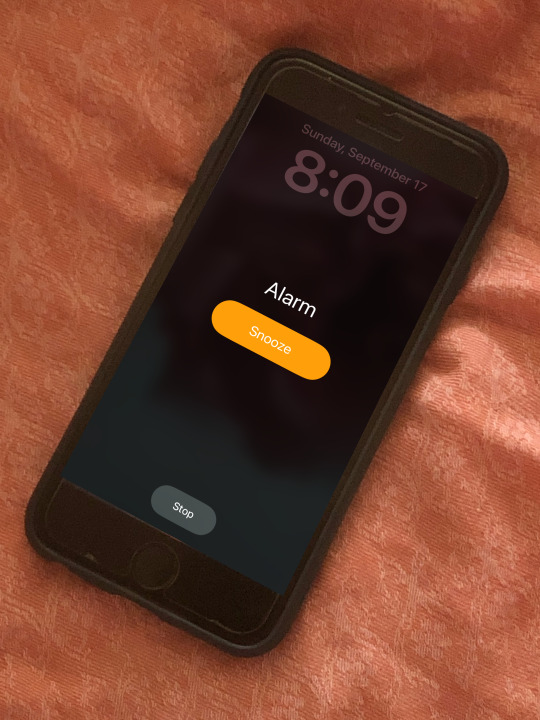
Productivity and academic
After getting myself ready for the day, I dive into working on the stuff I need to get done––academic or chore. My phone, tablet, laptop, and several software programs have evolved into my go-to working tools. For instance, Canvas, Gmeet, Gmail, and Zoom are examples of collaborative technologies that have changed the way I communicate with friends, peers, and family. Despite remotely studying and not personally seeing my blockmates and friends, technology brought connectivity to my life. Fortunately, whenever we have onsite classes, navigating or GPS applications direct me through my commute. Generally, It shows me real-time updates on traffic as well as suggestions on faster routes to avoid heavy traffic.
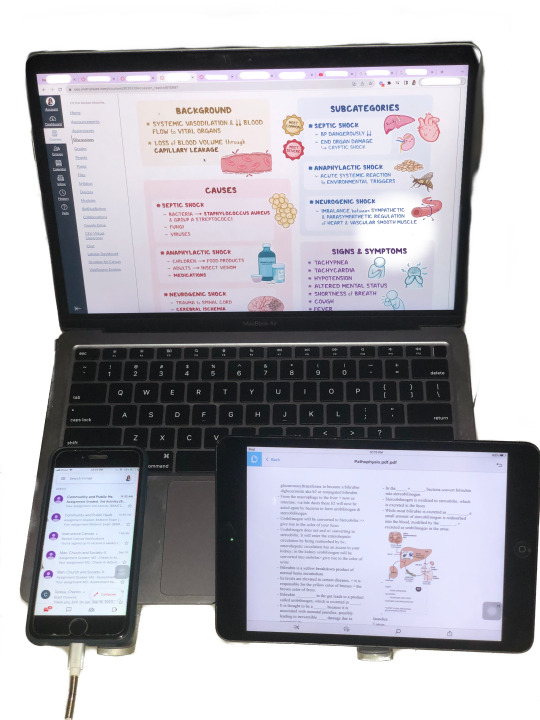
Primary health companion
Whenever I have extra time on my hands, I try my best to work out. Recently, I got a smartwatch with a fitness tracker app, and it has been nudging me to stand on my feet and move. Consequently, I found myself prioritizing my well-being and moving more often since it amazes me whenever it displays my progress.

Entertainment
Aside from working out, streaming movies is what keeps me busy. Streaming services such as Netflix and Disney+ have given me endless options of content to explore and watch. Furthermore, online shopping has also become a part of my regular activity. Admittedly, the ease of browsing for the items I need, adding them to my cart, and having them delivered right in front of my door amazes me. Additionally, mobile banking and cash app wallets such as Gcsh made managing finances easier. Generally, it eases the way I pay for the items I buy online or whenever I forget to bring cash with me.
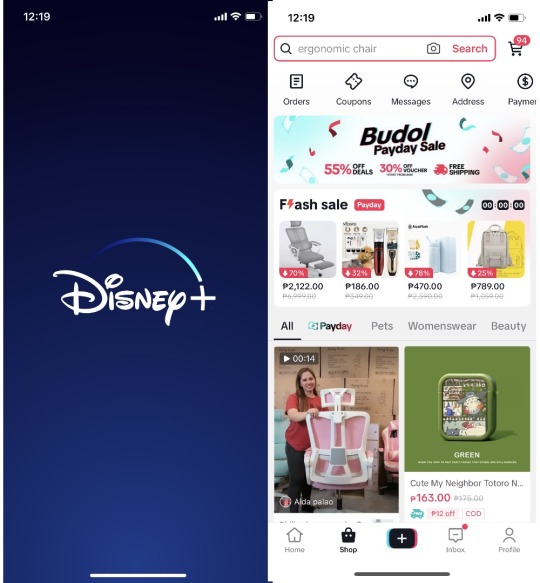
Bedtime
As the day draws to a close, I get ready before retiring to my bed. I then turn on a decent film or television show that will help me relax and easily sleep. Last but not least, I always make sure my alarm is set so I won't be late for my day tomorrow. And that's how my day-to-day activities go.
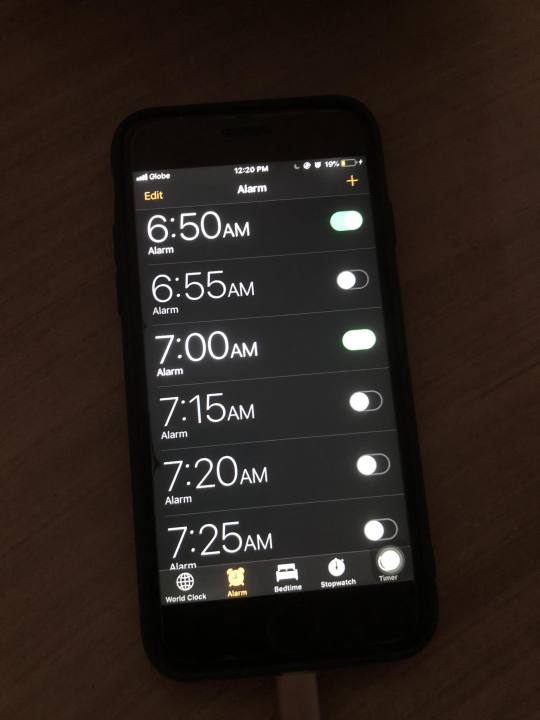
Technology has transformed how I manage my daily routines, but sometimes, I can't help but ponder and miss the days when technology was only a form of entertainment for me. Although it served as my timekeeper, guide, and connection to the outside world that brings convenience, efficiency, connectivity, and such, I always remind myself not to be overdependent on technology.
3 notes
·
View notes
Text
How to Choose the Best Refurbished Smartphones: A Comprehensive Guide
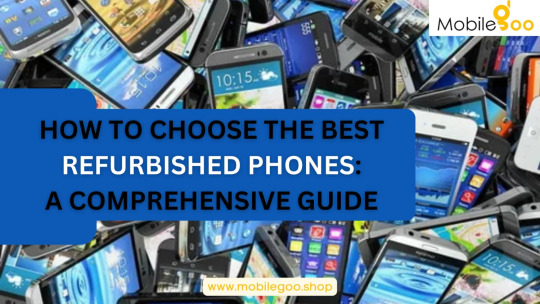
Refurbished smartphones are pre-owned devices that have been professionally restored to a like-new condition. They undergo a rigorous refurbishment process, which includes thorough inspection, repair, and replacement of faulty components. These devices are then tested to ensure optimal functionality and performance. By choosing a refurbished smartphone, you can save money while still enjoying the latest features and technologies.
What Are Refurbished Smartphones?
Refurbished smartphones are not the same as used or second-hand devices. Unlike used phones, refurbished phones go through a comprehensive refurbishment process to bring them back to a high-quality condition. The refurbishment process typically
involves cleaning, repair, replacement of faulty parts, and software updates. This ensures that the refurbished smartphones are in excellent working condition, free from defects, and ready for use.
Benefits of Buying Refurbished Smartphones
Opting for a refurbished smartphone comes with several advantages:
Cost-Effectiveness
Refurbished smartphones are significantly cheaper than their brand new counterparts, making them an affordable option for budget-conscious individuals.
Quality Assurance
Reputable sellers of refurbished smartphones ensure that devices undergo extensive testing and refurbishment processes, guaranteeing their quality and performance.
Environmental Friendliness
By choosing a refurbished smartphone, you contribute to reducing electronic waste and promoting sustainability.
Warranty and Support
Many refurbished smartphones come with warranties and after-sales support, providing peace of mind and protection against potential issues.
#certifiedrefurbishedphones#mobilegoo#refurbishment#refurbished#mobile#phone#mobilephone#refurbishedmobiles#refurbishedphone#openbox#unboxed#openboxphones#unboxedphones#secondhand#Secondhandmobile#secondhandphone#mobilegooshop#smartphone#mobilegoo_#refurbishediphone#AffordableSmartphone#onlinestore#onlineshop#quality#brand#like#iphone14#mobilephones#iphone#bestwebsitetobuyrefurbishedphone
3 notes
·
View notes
Text
Deciding on the Perfect Electric Vehicle (EV): A Comprehensive Buying Guide for 2023
The era of electric vehicles (EVs) is upon us, and as the market expands with a wide range of choices, it can be overwhelming to determine which EV is the best fit for your needs. This article aims to provide you with a comprehensive buying guide to help you make an informed decision when choosing an electric car that suits your lifestyle and preferences.

Consider Your Needs: Before diving into the myriad of options available, it is essential to assess your specific requirements. Consider factors such as your daily driving distance, charging infrastructure in your area, budget, desired features, passenger capacity, and cargo space. Understanding your needs will help narrow down your options and streamline your decision-making process.
Driving Range and Battery Capacity: One of the primary concerns for EV buyers is driving range. Consider your daily commuting distance and occasional longer trips to determine the ideal driving range for your needs. Most modern EVs offer a range of over 200 miles, with some high-end models exceeding 300 miles on a single charge. Additionally, pay attention to battery capacity and charging speeds, as they can affect your overall charging experience.
Charging Infrastructure: The availability and accessibility of charging stations are crucial factors to consider when purchasing an EV. Research the charging infrastructure in your area, including public charging stations, home charging options, and the convenience of fast-charging networks. Consider the time it takes to charge the vehicle fully and explore if any additional costs are associated with accessing specific charging networks.

Performance and Handling: Contrary to popular belief, electric vehicles are not solely focused on environmental friendliness—they offer exhilarating performance too. EVs are known for instant torque, providing impressive acceleration and a smooth driving experience. Research the acceleration times and handling characteristics of different models to find an EV that aligns with your driving preferences.
Features and Technology: Modern EVs are equipped with a plethora of advanced features and cutting-edge technology. Look for features such as regenerative braking, advanced driver-assistance systems, infotainment systems, smartphone integration, and over-the-air software updates. Additionally, examine the availability of charging-related applications and smart home integration to enhance your EV ownership experience.

Safety: Safety should always be a top priority when choosing a vehicle. Evaluate the safety ratings of different EV models by referring to organizations such as the National Highway Traffic Safety Administration (NHTSA) and the Insurance Institute for Highway Safety (IIHS). Look for features like advanced collision avoidance systems, lane-keeping assist, adaptive cruise control, and comprehensive airbag systems.
Cost of Ownership: While the initial purchase price of an EV can be higher than that of a traditional gasoline-powered vehicle, remember to factor in the long-term cost savings. EVs have lower operating and maintenance costs due to fewer moving parts and no need for oil changes. Additionally, research available federal and state incentives, tax credits, and potential fuel savings to determine the overall cost of ownership.
See Also: Which Car Should You Buy in 2023?
Brand and Model Reliability: Research the reliability and reputation of different EV brands and models. Look into customer reviews, independent studies, and the manufacturer's warranty offerings. Consider factors such as battery degradation over time and the availability of service centers to ensure a seamless ownership experience.
Conclusion: Choosing the right EV involves careful consideration of your specific needs, driving range requirements, charging infrastructure, performance attributes, features, safety ratings, cost of ownership, and brand reliability. By utilizing this comprehensive buying guide, you can make an informed decision and select an electric vehicle that aligns perfectly with your lifestyle, values, and driving preferences. Embrace the future of transportation with confidence and contribute to a sustainable, emissions-free future.
To explore a comprehensive list of top-rated electric vehicles and read expert reviews, head over to EVSea. They offer valuable insights and detailed analysis to help you find the perfect EV for your needs.
1 note
·
View note
Text
The Best Bluetooth House Speaker System to Consider in 2023
Bluetooth speakers have become increasingly popular over the years as a convenient and portable way to listen to music or audio from your smartphone, tablet, or other Bluetooth-enabled device. However, when it comes to a house speaker system, you need to consider more than just portability. The best Bluetooth house speaker system needs to provide excellent sound quality, have enough power to fill a room with sound, and be compatible with a variety of devices. In this guide, we will discuss the important factors to consider when buying a Bluetooth house speaker system, answer some frequently asked questions, and provide our top recommendations.

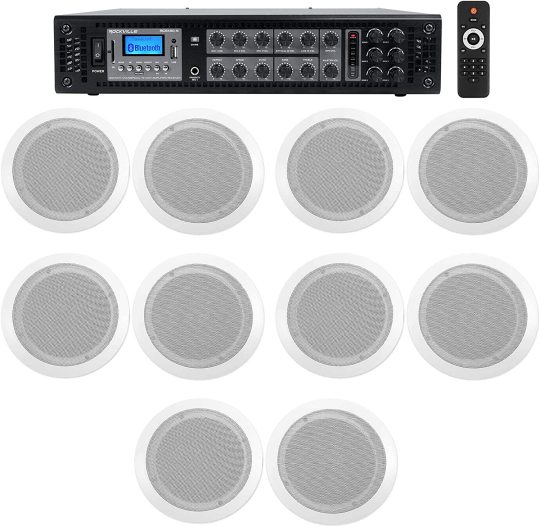
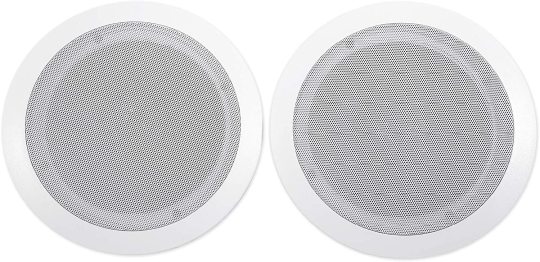
#jacobgolden#jacobgoldenmusic#musicalinstruments#bestbluetoothhousespeakersystem#bluetoothspeakersystem#housespeakersystem#rockville#bose#pyle
1 note
·
View note
Text
Here's the guide I started with!
And then I ended up buying this tiny little contraption and I am IN LOVE
I don't want my cellphone to have AI I want it to have 3 days of battery time. I don't want my computer to have AI preinstalled I want it to have seven usb ports and high ram at affordable price. I don't want my games to have AI built levels I want them to be so optimized I could run them on a nokia.
162K notes
·
View notes